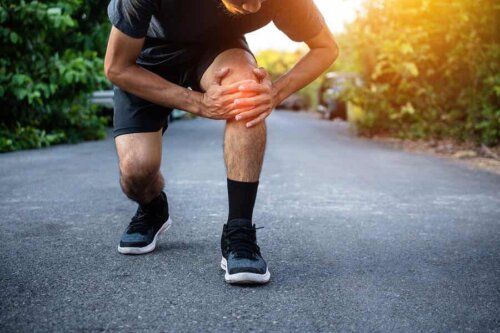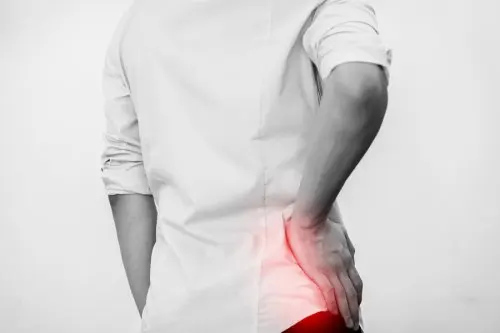What Is Bursitis and How Is It Treated?


Reviewed and approved by the doctor Diego Pereira
Bursitis is an inflammation that occurs in the bursa, a cushioning area located between the tendons, bones, and muscles.
When it appears, this disorder will hinder the movement of these areas and can cause considerable pain, and it would be essential to consult a primary care physician.
Although this condition usually affects people with certain types of jobs (especially those that require repetitive movements), it can also occur in other people.
Want to know more about this condition? In this article, we’re going to take a look at its main causes and treatment. Keep reading!
Causes and symptoms of bursitis

As already mentioned, bursae are bags filled with synovial fluid. They’re located in the rubbing areas of the joints and their function is to prevent friction between muscles, bones, and joints during movement.
Although there are about 150 bursae in the body, inflammation is more frequent in:
- Hips
- Shoulders
- Elbows
- Wrists
- Heels
- Knees
- Toes
The origins of this condition are still unknown, but as suggested by the U.S. National Library of Medicine, it could be due to multiple causes.
In addition to an overload, bursitis could also appear due to obesity, after suffering a trauma (from a fall, blow, or accident), as a consequence of an infection, or as a result of inflammatory diseases such as rheumatoid arthritis.
You may be interested in: 6 Questions to Ask before Exercising if You Have Arthritis
Types of bursitis
Bursitis can be classified into three types, according to the degree of prevalence over time. These are as follows:
1. Acute
Acute bursitis affects a joint and the area becomes red to the touch. As we have already mentioned, it can be a consequence of an overload, trauma, or gout.
2. Chronic

If someone with acute bursitis doesn’t treat it, it can become a chronic problem. Because of this, it’s is essential to consult a specialist as soon as the first symptoms come to light.
3. Trochanteric bursitis, the most serious type

Trochanteric bursitis is one of the most disabling that exist. It is usually produced in older people by a fall or blow, or by the weakening of the bursas with the passage of time.
According to Dr. Duque of the Hospital de La Princesa (Madrid), non-surgical treatment would be the first option to improve symptoms and avoid more serious problems. The physician may recommend:
- Infiltration of glucocorticoids and local analgesics
- Avoid activities that worsen the situation
- The use of anti-inflammatory drugs such as ibuprofen
- Using a cane or crutches for a period of time
- Physical therapy to increase hip flexibility and strength
If the doctor should recommend an operation (this is very rare) the most common technique is the removal of the bursa by means of an arthroscopy. After that, rehabilitation should be carried out for several weeks with plenty of rest.
How can you prevent bursitis?
There’s no completely effective way to prevent this condition. However, because this inflammation is sometimes caused by joint movement, care should be taken with certain habits.
Some ways to reduce the risk, as suggested by the Mayo Clinic, are the following:
- Applying heat for the pain
- Stretching the muscles at the end of physical activity
- Taking breaks when performing repetitive tasks
- Protecting the area with a knee or elbow pad (special pads)
- Using both hands to hold heavy tools
- Not spending long hours sitting
- Losing weight so as not to overload the knees
- Maintaining a correct posture
- Starting new activities or exercises
- Placing ice on the affected area
However, it should be remembered that, in some cases, the disease may appear for reasons that don’t depend directly on the affected person and their lifestyle. In such cases, preventive measures are insufficient.
How to treat bursitis
If you suffer from bursitis in the upper limbs (shoulders, hips, wrists, etc.) some exercises can help reduce the pain and increase the mobility and strength of the affected joint.
These should be performed under the supervision of a physiotherapist, and never on your own, as it could worsen the condition.
We recommend reading: 5 Simple Natural Remedies to Relieve Bursitis
It’s important to follow medical recommendations
It’s essential to follow all the guidelines set out by the doctor and the physiotherapist. In the case of chronic bursitis, it may also be beneficial to consult a psychologist, as the condition is quite disabling.
It’s possible to maintain good quality of life in these cases, as long as the patient receives psychological help to improve their mindset.
All cited sources were thoroughly reviewed by our team to ensure their quality, reliability, currency, and validity. The bibliography of this article was considered reliable and of academic or scientific accuracy.
- Clínica Mayo. https://www.mayoclinic.org/es-es/diseases-conditions/bursitis/diagnosis-treatment/drc-20353247
- Biblioteca Nacional de Medicina de Estados Unidos. https://medlineplus.gov/spanish/ency/article/000419.htm
- VV.AA. (2003). Bursitis trocantérea. http://scielo.isciii.es/scielo.php?pid=S1131-57682003000100006&script=sci_arttext&tlng=pt/
This text is provided for informational purposes only and does not replace consultation with a professional. If in doubt, consult your specialist.








